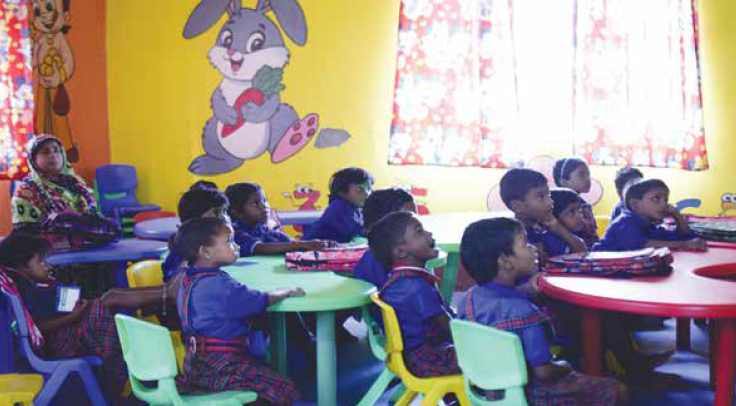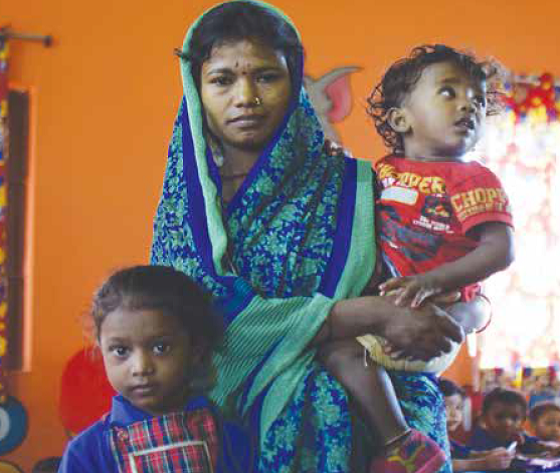Anganwadis as centres of nutrition
Anganwadis as centres of nutrition
Jharkhand is among the eight states which has been subjected to the intensive Integrate Child Development Scheme IV (ICDS-IV) due to the high drop-out rates of students from Anganwadi Centers(AWCs). This is prevalent in the aspirational districts, which are inhabited by tribal population. Therefore, under the ‘Universalization of ICDS with Quality,’ the concerned district administrations aim to reach the vulnerable sections of the population, the minorities and SC/ST.
The team of Aspirational District Fellows (ADFs), working under the Transformation of Aspirational Districts Program, and the respective district administration identified that inadequate infrastructure combined with insufficient education, and healthcare facilities contributed to the low attendance rates among AWCs. Building as a Learning Aid (BaLA), an initiative under the Sarva Shiksha Abhiyan (Universal Education), is commonly adopted in AWCs across Jharkhand. BaLA proposes that the structure and design of any school space should serve as a teaching tool. For example, painting the walls and ceilings of the AWCs with alphabets, numbers, animals, etc. such that the children are learning by observing their surroundings. The print rich environment becomes a child-friendly learning space. Anganwadi Workers (AWWs) are also benefited by this initiative as they use the visual content to enhance the understanding of the students.
The refurbished Anganwadis are termed as Model Anganwadis. The models of refurbishment varies across the districts of Jharkhand.
- Latehar district administration: Cost-effective, BaLA based model AWCs;
- Chatra district administrative: Model AWCs based on urban pre-school, with ICT equipment to add to the education and healthcare provisions
- Hazaribag district administration: Self-sustaining AWCs through the installation of biogas units or nutri gardens.
Smart Model Anganwadi in Chatra District
Chatra district is remotely located within the vast stretches of forests and coal mines. It is one of the 90 districts of India which is affected by Left Wing Extremism (LWE). Inaccessibility and violence, among other factors, contribute to the poor attendance and retention rates of students in the existing 196 AWCs. The Aspirational District Fellows (ADFs) of Chatra, Ashish Kumar and Neelesh Bhattacharyya, with the help of the district administration and AWWs, have refurbished the Anganwadis based on the urban pre-school model. This model envisions to attract students to improve learning and healthcare outcomes.

The AWCs in the Simaria block of Chatra district were selected for the pilot phase because they were unkempt with poor infrastructure. According to Jubi Dadi, a sevika, parents hesitated to send their children to school because they were not even given chairs to sit and study. Hence, improvement in infrastructure became the basis for model Anganwadis in Chatra. Therefore, the district administration under the guidance of DC, Shri Jitendra Kumar Singh (IAS), provided AWCs with proper infrastructure like cooking cylinders, tables, chairs, toys etc. Students were incentivized to attend sessions through the provision of school bags. The ADFs appointed painters to repaint based on BaLA guidelines. They proposed the installation of ICT devices such as television, speakers etc. to enhance the students’ learning through a smart environment. The total cost of refurbishment averaged to 2-3 lakhs, which was funded by the District Mineral Foundation (DMF).
The outcomes of these initiatives were in tandem with the vision of the smart AWC model. There was approximately a 35 percent increase in the attendance and retention rates, jumping from a merely 50 percent to approximately 85 percent. The ADFs along with the help of the Angadwadi Workers (AWWs) routinely monitor the attendance of the students.
The urban preschool model is not limited to educational outcomes. Replicating the level of sanitation at a preschool ensures a hygienic environment for the healthy growth of students. A clean environment improves the quality of food being served and the living conditions. Saiyas and Sevikas use television to stream videos on topics like anaemia, pregnancy, menstrual hygiene etc., to create awareness among adolescent girls and mothers. Hence, the smartness of the AWCs does not dampen its facilities.

The effectiveness of this model of transforming despondent AWCs to one of the top notch qualities has enthused the district administration to cover the remaining centres. They aim to use DMFT and SCA funds to undertake renovation. However, there are certain challenges in the implementation. First, the low salary of the AWWs disincentivize them to work up to their potential. Second, food promised to the students is different from the one served. Third, there is an absence of books and well-researched syllabus for promoting a higher early childhood literacy. Therefore, the Chatra administration and ADFs look forward to resolve the aforementioned issues with the help of smart ideas!
Source : Public System Strengthing in Aspirational Districts
Last Modified : 8/23/2021
This topic provides information about Model School...
This topic provides information about Narmada Tran...
This topic provides information regarding Transfor...
This Topic provides information about Solar powere...
